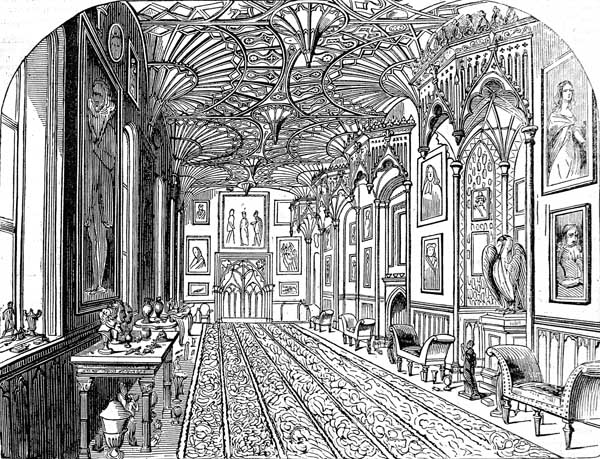 Strawberry Hill, the gothic-revival mansion in west London is currently in the midst of a £9m restoration. Martin Bailey has a terrific story in the Art Newspaper on the efforts to track down many of the objects which were originally included in the mansion.
Strawberry Hill, the gothic-revival mansion in west London is currently in the midst of a £9m restoration. Martin Bailey has a terrific story in the Art Newspaper on the efforts to track down many of the objects which were originally included in the mansion.
Horace Walpole built the home in the 18th century, which is credited for the revival of the Gothic style in Victorian England. The building was inspired by the fan vaulting at Westminster Abbey, bits of tombs from Westminster and Canterbury, and the tomb of Edward the Confessor. When Walpole died in 1797, most of the objects remained at the mansion, but an auction in 1842 led to the loss of a number of the objects. The Strawberry Hill Trust is now eager to bring these objects back together, including paintings, sculpture, furniture, ceramics, glassware, weapons, relics and manuscripts.
Some of the most sought-after items include:
1. A Roman funerary urn: The Roman urn appears below the window in a 1750s drawing of Walpole in his library by Johann Müntz. Its triangular top decoration has a tripod relief, supported by griffins.2. Mirror with portrait of Viscount Malpas: There were two mirrors, and the lost mirror has a circular painting of Viscount Malpas. The Gothic mirror, with an ebonised wood frame, was sold in 1842 to Mrs Dawson Damer. Another mirror depicting the Earl of Orford survives (pictured, it was accepted in lieu of inheritance tax last year and will be displayed at Strawberry Hill).3. Ornate Turkish dagger: The ornate dagger was reputed to have belonged to Henry VIII. In 1842 it was bought by actor Charles Kean, who is said to have used it on the stage. It was sold at Christie’s in 1898 to someone named as Haigham. It is depicted in a late 18th-century watercolour.4. Gothic dining table Commissioned by Walpole in 1754, the top is of Sicilian jasper (6 x 3 feet), with the frame in black. An early 19th-century drawing of it survives. The ornately decorated table was last recorded in 1953, when it was owned by antiquarian Harry Bradfer-Lawrence, of Ripon, Yorkshire, who died in 1965.5. Basalt Bust of Vespasian: The colossal basalt bust had been in 10 Downing Street and was later put on display at Strawberry Hill. It is depicted in a watercolour view of Horace Walpole’s gallery. The bust was last recorded at Christie’s in 1893, after leaving the Hamilton Palace collection.
- Martin Bailey, Strawberry Hill on the hunt for lost Walpole treasures, The Art Newspaper, January 6, 2010.





